Ronda - a city in the clouds. Discover the pearl of Andalusia
10/10/2022
2022-10-11 14:02Ronda - a city of spectacular views and breathtaking history. Magnificent architecture and the surrounding greenery of orange trees and olive groves. A city of brave matadors and spiritual writers and poets. At the same time, inspiring and awe-inspiring. Which is not surprising, because being in Ronda, it's hard not to feel the drama of its location and the events taking place here centuries ago. What is this city suspended in the clouds? Why is it worth visiting Ronda and what to see in it?
What you will find in the article:
Where is Ronda in Spain?
Ronda is located in Andalucia in southern Spain. Although it is not located directly on the Mediterranean Sea, Ronda is one of the most visited cities on the Costa del Sol. It is well connected with Malaga, Marbella and other resorts on the Coast, from where the journey by car takes no more than 2 hours.
Ronda is one of the most beautiful and popular pueblos blancos and the largest white town in Andalusia, which has kept its old atmosphere, free from skyscrapers and glass houses. It is quite small and easy to get around on foot. Its narrow streets lead to beautiful nooks, enchant with traditional whitewashed houses and delight with the multitude of flowers that abundantly decorate the balconies.

It is located 780 m above sea level, rises high on the hills with a unique, even spectacular view of the gorge. El Tajo is the heart of Ronda, it crosses its center and divides the city into two parts. On one side is La Ciudad, the Moorish old town, and on the other side is the 15th century "new" city of El Mercadillo.
When to visit Ronda?
Ronda is visited by tourists all year round. The peak of the season is of course in the summer - in July and August it is not so hot here, and the average temperatures reach 26-30 ° C.
It is also warm and dry here in spring and autumn. The city is not as crowded then as in summer, what's more, the spectacle is then given by nature, which just explodes with greenness and the intensity of flowers' colors, or when the leaves change their color.
Winters in Ronda are short and mild, with average daytime temperatures of 14 ° C. However, from November to January it rains the most, although the rainy weather usually lasts for several days a month.
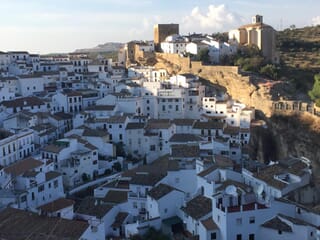
Ronda - what to eat?
The geographical location of Ronda and the sunny weather almost all year round guarantee rich cultivation of fruit and vegetables typical of Mediterranean cuisine. Tomatoes, peppers and broad beans grow in the area. Fresh seafood comes from the coast. In numerous tapas restaurants you can try dozens of types of snacks, including such classics as Iberian ham, stuffed peppers, octopus salad, snails and clams.
The area around Ronda is also famous for wine growing - several well-known, award-winning wines come from this area. Lovers of this drink can not only taste it, but also visit vineyards, listen to wine production or take part in workshops
Ronda - a city with history
Ronda is one of the oldest cities in all of Spain and you can feel it everywhere. Echoes of a turbulent past resound all around here. You can feel them in cobbled streets, old mansions and stone churches.
Ronda was founded by the Celts as early as the 6th century. Over the years, as a result of endless bloody battles and religious reforms, it changed hands. It was inhabited by the Phoenicians, and after the fall of the Roman Empire - the Visigoths. In the eighth century it was taken by the Moors. It was conquered by Christians in the 15th century.
Today, the remnants of every culture and period of history still remind us of how it was created. The geography of the city itself is a spectacle in itself. There is even a legend that the city was united centuries ago. However, due to the constant fighting on its territory, the gods tore the city - this is how the gorge was created. This was to stop the townspeople from shedding blood.
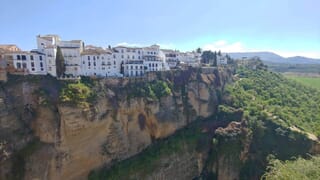
Ronda is a Mecca for artists
The unique location, amazing architecture, the atmosphere prevailing in the city and numerous legends associated with it - all this built the spirit of the city and contributed to the creation of its romantic idea. And this one has attracted many famous seekers, romantic travelers, artists and writers. They were associated with the city, among others the American director Orson Welles, the French writer Alexander Dumas or the famous German poet Rainer Maria Rilke. The Ronda was also portrayed by the visiting American writer Ernest Hemingway in his novel “For Whom the Bell Tolls”. The images of bullfight in his paintings were immortalized by the Spanish painter Francisco de Goya.
What to see in Ronda?
Puente Nuevo and other bridges
The 100-meter deep and 400-meter long gorge running through the city center is the flagship of Andalusia and the biggest tourist attraction in Ronda. However, it cannot be denied that it is a significant impediment to city traffic, which was already dealt with hundreds of years ago - by building 3 bridges connecting both parts of the city.
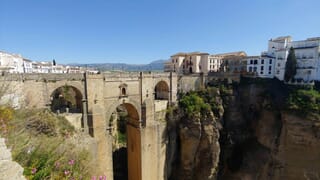
Puente Nuevo, or the New Bridge
The newest and greatest of all three. Its name, however, can be misleading as it is not really new: it is now over 200 years old. It was completed in 1793, and the work on it, according to the design of the architect José Martín de Aldehueli, lasted nearly 40 years. Since then, he has witnessed many historical events, including the Spanish Civil War, during which convicts were thrown from a bridge. Over the central arch of the bridge, there is a room that was to be used as a torture chamber and a prison during the war. Currently, there is a museum with an exhibition about the construction of the bridge.
Today, Puente Nuevo is Ronda's most famous landmark and its symbol on postcards: a gigantic triple arch with columns reaching 120 meters into the gorge.
Puente Viejo, or the Old Bridge
Bridge built in the 16th century and restored in the 20th century. Currently, it is only open to pedestrian traffic.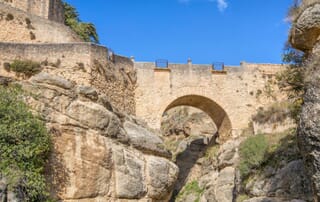
San Miguel Bridge, also known as the Arabian Bridge
An Islamic bridge built in the 12th century. Until the end of the 15th century, it was called the Roman bridge.
The bottom of the El Tajo gorge
You can reach the bottom of the gorge, overlooking the high Puente Nuevo bridge, by taking a path from Plaza de Maria Auxiliadora. There are several viewpoints along the way from which you can admire this spectacular 18th century masterpiece. At the bottom of the gorge, you can follow the Guadalevín River or see the ruined flour mills on Carretera de los Molinos, which were destroyed by the 1917 earthquake.
Alameda del Tajo
A 19th-century small park consisting of five tree-lined avenues leading to the edge of the cliff. It is a meeting place for the inhabitants of Ronda and a destination for tourists visiting the city. The viewpoints located above the gorge itself invite to have a look out over the surrounding area and down into the gorge. However, this is an attraction for strollers with strong nerves, because the panoramic balconies are located just above the abyss. The risk is worth the price - breathtaking panoramas can be seen from the cliff's edge.
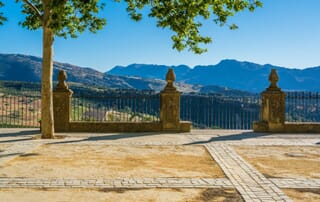
Plaza del Toros, one of the oldest bullfighting arena in Spain
It is a place with which a large part of the history and culture of the city is associated. It is one of the oldest and most magnificent bullfighting arenas in all of Spain. It was also designed by the architect Jose Martin de Aldehuela. The facility with a capacity of 5,000 spectators was built in 1785.
Currently, there is only one bullfighting event in the Plaza del Toros a year. Cultural meetings and concerts are held here more often. The building also houses a museum dedicated to the history of the bullfight.
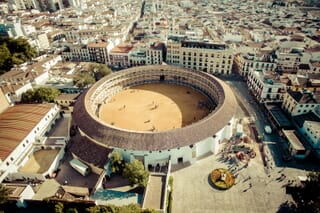
Arab baths
Located in the San Miguel district, the Arab Baths in Ronda are one of the best preserved of its kind in Spain. This is another element of Arab culture in the city. They come from the 12th century, when the city was ruled by the Moors. They were used for ablution before visiting the mosque. They are partly underground, but star-shaped vents in the ceiling let light in and let out steam.
Casa del Rey Moro
Casa del Rey Moro - House of the Moorish King, although it was built on the site of the original Moorish well, dates back to the 18th century, so long after the reign of the Moors. The facility is not open to visitors. Guests are only allowed to walk in the gardens, established in 1912, situated on terraces built into the hillside. A tunnel leads from the gardens to the bottom of the El Tajo gorge, which made it possible to safely draw water when the city was under siege.
Old Town
The historic Andalusian style of Ronda is situated in the southern part of the city. The old town has beautiful whitewashed houses, unique iron balustrades and wooden doors typical of this style, historic churches and beautiful squares, as well as flowers densely planted in pots decorating the buildings.
The Old Town's main square, Plaza Duquesa de Parcent, is delightful. Beautiful buildings surround the church of Iglesia de Santa María de la Encarnación la Mayor with a bell tower recognized as a national monument. Built on the site of a mosque, the temple is a mixture of Renaissance, Gothic and Baroque styles.
